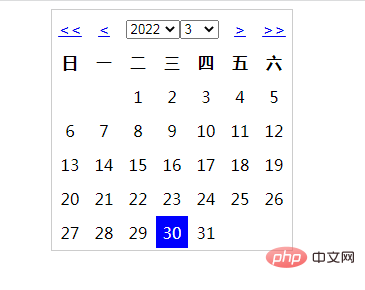怎么使用PHP实现简单的日历程序?本篇文章就通过一个代码示例来大家了解一下使用PHP实现简单日历程序的方法,希望对大家有帮助。

说到对日期和时间的处理,就一定要介绍一下日历程序的编写,大多数读者可能都会认为日历的作用只是为了在页面上显示当前的日期,其实不然,日历在我们的开发中有着更重要的作用。例如,我们开发一个“记事本”就需要通过日历设定日期,另外在一些系统中需要按日期去安排任务也需要用到日历等等。
本节的示例中涉及的日期和时间函数并不是很多,都是前面介绍的,主要是通过编写一个日历类来巩固一下前面介绍的面向对象,以及时间函数应用,同时示例中涉及到一些前端知识,感兴趣的读者可以阅读本站提供的 HTML教程 和 CSS 教程。
完整的示例代码如下所示:
<?php
class Calendar{
private $year, $month, $start_week, $days;
/**
* 构造方法,用来初始化一些日期属性
*/
function __construct(){
$this->year = isset($_GET['year'])?$_GET['year']:date('Y');
$this->month = isset($_GET['month'])?$_GET['month']:date('m');
$this->start_week = date('w', mktime(0, 0, 0, $this->month, 1, $this->year));
$this->days = date('t', mktime(0, 0, 0, $this->month, 1, $this->year));
}
/**
* 魔术方法,用来打印整个日历
* @return string [日历的html代码]
*/
function __toString(){
$output = '';
$output = '<table>';
$output .= $this->changeDate();
$output .= $this->weeksList();
$output .= $this->daysList();
$output .= '</table>';
return $output;
}
/**
* 输出周列表
* @return [string] [html 代码]
*/
private function weeksList($output=''){
$week = array('日','一','二','三','四','五','六');
$output .= '<tr>';
for ($i=0; $i < count($week); $i++) {
$output .= '<th>'.$week[$i].'</th>';
}
$output .= '</tr>';
return $output;
}
/**
* 输出日期列表
* @return [string]
*/
private function daysList($output=''){
$output .= '<tr>';
for ($i=0; $i < $this->start_week; $i++) {
$output .= '<td> </td>';
}
for ($j=1; $j <= $this->days; $j++) {
$i++;
if($j == date('d') && $this->year == date('Y') && $this->month == date('m')){
$output .= '<td>'.$j.'</td>';
}else{
$output .= '<td>'.$j.'</td>';
}
if($i%7 == 0) $output .= '</tr><tr>';
}
while($i%7 !== 0){
$output .= '<td> </td>';
$i++;
}
$output .= '</tr>';
return $output;
}
/**
* 处理上一年的数据
* @param [type] $year [年份]
* @param [type] $month [月份]
* @return [type] [description]
*/
private function prevYear($year, $month){
$year -= 1;
if($year < 1970) $year = 1970;
return "year=$year&month=$month";
}
/**
* 处理上一月的数据
* @param [type] $year [年份]
* @param [type] $month [月份]
* @return [type] [description]
*/
private function prevMonth($year, $month){
if($month == 1){
$year -= 1;
if($year < 1970) $year = 1970;
$month = 12;
}else{
$month--;
}
return "year=$year&month=$month";
}
/**
* 处理下一年的数据
* @param [type] $year [年份]
* @param [type] $month [月份]
* @return [type] [description]
*/
private function nextYear($year, $month){
$year += 1;
if($year > 2038) $year = 2038;
return "year=$year&month=$month";
}
/**
* 处理下一月的数据
* @param [type] $year [年份]
* @param [type] $month [月份]
* @return [type] [description]
*/
private function nextMonth($year, $month){
if($month == 12){
$year --;
if($year > 2038) $year = 2038;
$month = 1;
}else{
$month++;
}
return "year=$year&month=$month";
}
/**
* 调整年份和月份
* @param string $output [html代码]
* @param string $url
* @return [type]
*/
private function changeDate($output='', $url='index.php'){
$output .= '<tr>';
$output .= '<td><a href="'.$url.'?'.$this->prevYear($this->year, $this->month).'">'.'<<'.'</a></td>';
$output .= '<td><a href="'.$url.'?'.$this->prevMonth($this->year, $this->month).'">'.'<'.'</a></td>';
$output .= '<td colspan="3">';
$output .= '<form>';
$output .= '<select name="year" onchange="window.location=\''.$url.'?year=\'+this.options[selectedIndex].value+\'&month='.$this->month.'\'">';
for ($i=1970; $i <=2038; $i++) {
$selected = ($i == $this->year)?'selected="selected"':'';
$output .= '<option value="'.$i.'" '.$selected.'>'.$i.'</option>';
}
$output .= '</select>';
$output .= '<select name="month" onchange="window.location=\''.$url.'?year='.$this->year.'&month=\'+this.options[selectedIndex].value">';
for ($j=1; $j <=12; $j++) {
$selected = ($j == $this->month)?'selected="selected"':'';
$output .= '<option value="'.$j.'" '.$selected.'>'.$j.'</option>';
}
$output .= '</select>';
$output .= '</form>';
$output .= '</td>';
$output .= '<td><a href="'.$url.'?'.$this->nextMonth($this->year, $this->month).'">'.'>'.'</a></td>';
$output .= '<td><a href="'.$url.'?'.$this->nextYear($this->year, $this->month).'">'.'>>'.'</a></td>';
$output .= '</tr>';
return $output;
}
}
?>
<!DOCTYPE html>
<html>
<head>
<meta charset="UTF-8">
<title>PHP实现简单的日历程序</title>
<style>
table{
border: 1px solid #ccc;
}
.fontb{
color: white;
background: blue;
}
th{
width: 30px;
}
td,th{
height:30px;
text-align: center;
}
form{
margin: 0px;
padding: 0px;
}
</style>
</head>
<body>
<?php
$calendar = new Calendar;
echo $calendar;
?>
</body>
</html>运行结果如下图所示:

推荐学习:《PHP视频教程》
 unset()和session_destroy()有什么区别?May 04, 2025 am 12:19 AM
unset()和session_destroy()有什么区别?May 04, 2025 am 12:19 AMThedifferencebetweenunset()andsession_destroy()isthatunset()clearsspecificsessionvariableswhilekeepingthesessionactive,whereassession_destroy()terminatestheentiresession.1)Useunset()toremovespecificsessionvariableswithoutaffectingthesession'soveralls
 在负载平衡的情况下,什么是粘性会话(会话亲和力)?May 04, 2025 am 12:16 AM
在负载平衡的情况下,什么是粘性会话(会话亲和力)?May 04, 2025 am 12:16 AMstickysessensureuserRequestSarerOutedTothesMeServerForsessionDataConsisterency.1)sessionIdentificeAssificationAssigeaSsignAssignSignSuserServerServerSustersusiseCookiesorUrlModifications.2)一致的ententRoutingDirectSsssssubsequeSssubsequeSubsequestrequestSameSameserver.3)loadBellankingDisteributesNebutesneNewuserEreNevuseRe.3)
 PHP中有哪些不同的会话保存处理程序?May 04, 2025 am 12:14 AM
PHP中有哪些不同的会话保存处理程序?May 04, 2025 am 12:14 AMphpoffersvarioussessionsionsavehandlers:1)文件:默认,简单的ButMayBottLeneckonHigh-trafficsites.2)Memcached:高性能,Idealforsforspeed-Criticalapplications.3)REDIS:redis:similartomemememememcached,withddeddeddedpassistence.4)withddeddedpassistence.4)databases:gelifforcontrati forforcontrati,有用
 PHP中的会话是什么?为什么使用它们?May 04, 2025 am 12:12 AM
PHP中的会话是什么?为什么使用它们?May 04, 2025 am 12:12 AMPHP中的session是用于在服务器端保存用户数据以在多个请求之间保持状态的机制。具体来说,1)session通过session_start()函数启动,并通过$_SESSION超级全局数组存储和读取数据;2)session数据默认存储在服务器的临时文件中,但可通过数据库或内存存储优化;3)使用session可以实现用户登录状态跟踪和购物车管理等功能;4)需要注意session的安全传输和性能优化,以确保应用的安全性和效率。
 说明PHP会话的生命周期。May 04, 2025 am 12:04 AM
说明PHP会话的生命周期。May 04, 2025 am 12:04 AMPHPsessionsstartwithsession_start(),whichgeneratesauniqueIDandcreatesaserverfile;theypersistacrossrequestsandcanbemanuallyendedwithsession_destroy().1)Sessionsbeginwhensession_start()iscalled,creatingauniqueIDandserverfile.2)Theycontinueasdataisloade
 绝对会话超时有什么区别?May 03, 2025 am 12:21 AM
绝对会话超时有什么区别?May 03, 2025 am 12:21 AM绝对会话超时从会话创建时开始计时,闲置会话超时则从用户无操作时开始计时。绝对会话超时适用于需要严格控制会话生命周期的场景,如金融应用;闲置会话超时适合希望用户长时间保持会话活跃的应用,如社交媒体。
 如果会话在服务器上不起作用,您将采取什么步骤?May 03, 2025 am 12:19 AM
如果会话在服务器上不起作用,您将采取什么步骤?May 03, 2025 am 12:19 AM服务器会话失效可以通过以下步骤解决:1.检查服务器配置,确保会话设置正确。2.验证客户端cookies,确认浏览器支持并正确发送。3.检查会话存储服务,如Redis,确保其正常运行。4.审查应用代码,确保会话逻辑正确。通过这些步骤,可以有效诊断和修复会话问题,提升用户体验。
 session_start()函数的意义是什么?May 03, 2025 am 12:18 AM
session_start()函数的意义是什么?May 03, 2025 am 12:18 AMsession_start()iscucialinphpformanagingusersessions.1)ItInitiateSanewsessionifnoneexists,2)resumesanexistingsessions,and3)setsasesessionCookieforContinuityActinuityAccontinuityAcconActInityAcconActInityAcconAccRequests,EnablingApplicationsApplicationsLikeUseAppericationLikeUseAthenticationalticationaltication and PersersonalizedContentent。


热AI工具

Undresser.AI Undress
人工智能驱动的应用程序,用于创建逼真的裸体照片

AI Clothes Remover
用于从照片中去除衣服的在线人工智能工具。

Undress AI Tool
免费脱衣服图片

Clothoff.io
AI脱衣机

Video Face Swap
使用我们完全免费的人工智能换脸工具轻松在任何视频中换脸!

热门文章

热工具

EditPlus 中文破解版
体积小,语法高亮,不支持代码提示功能

Dreamweaver CS6
视觉化网页开发工具

SublimeText3汉化版
中文版,非常好用

记事本++7.3.1
好用且免费的代码编辑器

SublimeText3 Mac版
神级代码编辑软件(SublimeText3)





